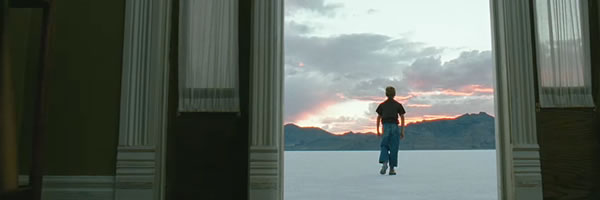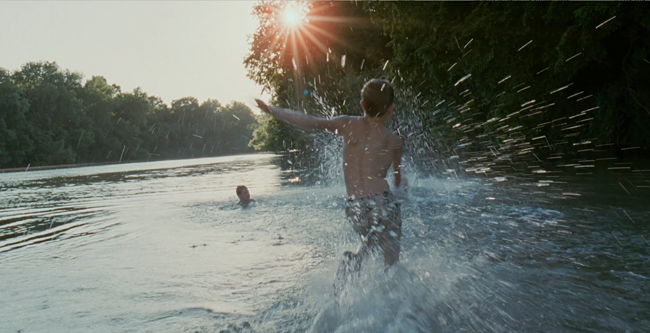Life, the universe and everything. It's tempting to appropriate the title of the third of Douglas Adams' "Hitchhiker" novels toward the end of finding something big enough to do justice to Terrence Malick's fifth feature, The Tree of Life. Of course, Adams' titles and books were full of whimsy and irony. Both the great strength and dragging limitation of The Tree of Life is its absolute sincerity.
Apparently first conceived as film called Q after his great Days of Heaven, this latest film from the writer/director is at least partially the fruition of that ambitious origins of life on Earth project. For good and bad, The Tree of Life has the look and bursting at the seams feel of something that has been worked on and worked over for decades.
There is here all one usually finds in Malick. There is the spare dialog which occurs often in the form of whispery statements, an evolution from the relatively conventional female voice-overs in Badlands and Days of Heaven to the internal monologues or meditations of The Thin Red Line and The New World. Here the utterances are somewhere between the latter and outright conversations with God. There is the continued dwelling in the past. Perhaps this is a way for Mr. Malick to illuminate the present by refracting it through that past. Perhaps it's a more simple, self-indulgent penchant for nostalgia. Throughout his films and most powerfully in The Tree of Life, there is a sense of paradise lost, of happiness, even bliss having been at one's fingertips, before slipping away. Like much of what we see in The Tree of Life, it's a heady mix of the Biblical and the personal. Whatever the case, it's a resonant theme and perhaps the world's oldest. How many of us fail to live contentedly in the present, feel that real happiness has somehow just eluded us, some key moment not recognized, some important past decision gotten wrong? The visual poetry that often reflects Mr. Malick's feeling for the natural world unfurled so memorably in his previous four films is again on display throughout The Tree of Life. Also, in the words of a slightly lesser poet, everything is beautiful. This applies not only to Malick's obvious sensitivity to the natural world, but to inanimate objects therein, to cars, households, furniture and dress. It also applies to the actors he employs. It's hard to find a lead actor in any of his five features who's not striking in one way or another. The main justification for Richard Gere's presence in the great Days of Heaven would seem to be his cheekbones. Beyond the million dollar bone structure, Gere sports a scarf and more than passable suit through a good portion of Days of Heaven. Whether laboring in a Chicago steel mill or working a farm in the Texas panhandle, Gere cuts a rather dashing figure for a impecunious drifter.
The Tree of Life positively teems with beauty. The leads are typically handsome, particularly Jessica Chastain, going about her motherly rounds in a series of simple, elegant dresses draped perfectly over her dancer's frame. It's true of the households and most every object they contain, however simple. And, of course, it's the case with that natural of world of the film's Texas setting. There's much consideration of the caress of trees in full bloom by some impetuous wind, the accompanying rustle of leaves. Light diffused through curtains and playing on the walls, the sort of luminous evanescence that seems a haunting, gentle signal from another world when you descry it. Mallick's gaze misses little of such things. Water from a garden hose gurgling over the lips and down a shin to wash away stray blades of grass on Mrs. Obrien's leg. A field of sunflowers, a crowded composition of the plants standing uncanny and alert. Even the one birth we see from Mrs. O'Brien (Chastain) has the mother and all attending her clad impeccably in white. She's allowed a mute scream, but there's nary an indication of blood or placenta. I believe Mr. Malick knows the facts of life. It's an aesthetic choice. One could spend days cataloging the beauty in The Tree of Life.
While the feeling of paradise lost is not new to Malick films, in the case of The Tree of Life, that obscure object of temporal desire is not so obscure. It is a lost brother and son. After some fleeting glances of the Obrien's life in 1950's Waco, we see bad news delivered to the parents some years ahead. Mrs. Obrien reads a telegram in an impeccably decorated mid-century home, her husband takes a phone call adjacent to a roaring, shining plane on an airfield. There's no explicit revelation, but the nature of the news is clear enough. The couple, so different in personality, respond in a similar manner, as if each has taken a blow to the solar plexus.
The death of R.L, one of the younger Obrien boys haunts the oldest, Jack, into his adult life. We're sent ahead to an unprecedented place in a Terrence Malick film, the relative present. There we find an obviously discontented Jack (Sean Penn), an architect residing in yet another almost hermetically modern dwelling. He seems no more happily paired that his parents; there's a telling shot of his attractive wife or partner sitting on the opposite side of their bed; their backs are turned to one another. The older Jack seems to wander through his day at loose ends. "The world's gone to the dogs," he says, in one of the few lines of audible dialog Penn is allowed. There are flashbacks to his youth. In phone conversation with his father, he apologizes for a careless remark about R.L., and admits, "I think about him every day."
Mr. Malick then interrupts this regularly scheduled program of familial strife and longing for the creation of the world. Really. There are blades of celestial light. There is a big bang of sorts. We see the fiery, volcanic creation of our Earth right up to the time of the dinosaurs. As if heralding the minor theme of sibling rivalry, the mid-50's Cain and Able travails of Jack and R.L., there is even a strange encounter when a parasaurolopus lies apparently injured in a stream bed. A troodon spots the vulnerable creature, trots across the water and then holds the defenseless dinosaur's head down before releasing it and running off. Ultimately there is a shot from the vantage point of outer space of what may well be a meteor strike, signaling the end of the dinosaurs.
Make of it what you will, the roughly quarter hour sequence is, typical for Malick, visually rich. This we can attribute to the director's sensibilities (e.g., no CGI) and a collaboration with veteran special effects craftsman Douglas Trumball. Mr. Trumball worked, most famously perhaps, with Stanley Kubrick on "2001." That link, along with The Tree of Life's cosmic scope and often booming score has led to many comparisons between the two films, despite how emotionally disparate are the two stories and directors.
Occasionally, as the world is taking shape amongst all the fire and crashing of waves, the music gives way to sotto voce existential questions and statements. These emanate mainly from a grieving Mrs. Obrien, as when she is heard to say, "We cry to you. My soul. My son. Hear us." While regarding all of this, it would seem that audiences too are involved in their own questioning, those of a why or what nature. Or, it would seem, that most simple and profound of existential queries: Huh?
The Tree of Life begins with a title card that bears an excerpt from the book of Job “Where were you when I laid the foundations of the earth? When the morning stars sang together, and all the sons of God shouted for joy?” More from the same Old Testament book is later heard during the funeral of R.L. This the apparent justification for all the creation to which we are witness, as well as an answer to Mrs. O'Brien and all the mournful souls through the ages, with their questions like "Where were you?" or "How could you let this happen." Unfortunately, this casts the creator of the world in the position of grouchy parent, reminding his or her ingrate children about all that has been done to lay the foundation of their lives, to which they seem to be clueless. Mr. Malick's seriousness of purpose, his sincerity seem nearly as admirable has his visual instincts are unimpeachable. And much as his might be a broad spirituality, transcending any narrow Christianity to something even in an enlightened Judeo-Christian tradition, it's still a creaky old model to those who don't choose to interpret the world in such a manner. More to the point, as intellectually ambitious as this film wants to be, it tries to fit itself into a belief system which is antithetical to intellecual inquiry; it hits the wall where real questioning has to stop and faith begins.
However, there is considerable value in provoking thought and debate, even if you choose to reject the over-arching vision in The Tree of Life. More problematic is how Malick's cosmology fails to meld to any satisfactory degree with the story of Jack O'Brien and his family. That meteor strike at the end of the creation sequence seques to a pregnant Mrs O'Brien in 1950's Waco. The creation of the universe down to the creation of one soul. It's one of the director's attempts to converge the cosmic and personal narratives.
It might be an Eden of sorts, the O'Brien's early family life, but the placid waters mirroring all the beauty about them are made to roil. The tempest comes mainly, though not exclusively, in the form of Mr. O'Brien. The father is something of a Brahm's blaring Great Santini, much as he seems to long for more of an emotional connection with his boys. His "Do you love your father?" or "Give your father a hug," with which he sometimes casts at Jack and his younger sons come as more commands from a safe distance than vulnerable pleas for affection. Sadly, the responses come dutifully in kind. Mr. O'Brien is an exacting man of frustrated aspirations and his family often suffers his anger. This may not be Pitt's best acting, but he certainly looks the archetype he's meant to inhabit, with his somewhat severe crew cut, often resolutely extended lower lip and handsome face showing the eclipse of the years and toll of failed ambitions.
As for Mrs. O'Brien, early in The Tree of Life, we hear her say something she was taught during her Catholic schooling, "There are two ways in life: the way of nature and the way of grace. It's a dichotomy that seems to apply to the couple as well as the tug of war within their eldest son. Jessica Chastain does well to convey the considerable emotion she gets across as the wife and mother; it is, perhaps, rather more difficult to embody grace than nature. Mrs. Obrien is an ethereal presence, almost child-like and happily conspiratorial with her boys at times when she enjoys the absence of her husband's harsh authority.
Through the many happy and troubling moments that we witness, the impeccable images and mise-en-scene so typical of Malick's films are due in part to the good work of production designer Jack Fisk and cinematographer Emmanuel Lubezki.
The great strength of the Tree of Life is the family story, specifically the travails of Jack and his brothers. The film's strongest performances might well be those of Hunter McCracken, Laramie Eppler and Tye Sheridan as the O'Brien boys, particularly McCracken as the jug-eared, wary Jack.
 The redoubtable Sean Penn struggles more with his adult version of Jack. While the preponderance of time post-creation is judiciously spent on the family life in 1950's Waco and Jack's difficult entry into adolescence, there are brief returns to both the blades of light that began the creation sequence and to wanderings of the adult Jack. These wanderings go from the emotional to the literal, with Jack seen stepping unsurely about a desert landscape. Penn has a face that bespeaks its share of turmoil. He's always been able to act powerfully without dialog - witness the lifeless eyes of Matthew Poncelet in Dead Man Walking. Unfortunately, he's given too vague a sense of direction by Terrence Malick and seems the most underutilized member of the cast.
The redoubtable Sean Penn struggles more with his adult version of Jack. While the preponderance of time post-creation is judiciously spent on the family life in 1950's Waco and Jack's difficult entry into adolescence, there are brief returns to both the blades of light that began the creation sequence and to wanderings of the adult Jack. These wanderings go from the emotional to the literal, with Jack seen stepping unsurely about a desert landscape. Penn has a face that bespeaks its share of turmoil. He's always been able to act powerfully without dialog - witness the lifeless eyes of Matthew Poncelet in Dead Man Walking. Unfortunately, he's given too vague a sense of direction by Terrence Malick and seems the most underutilized member of the cast. Beyond it's obvious and abundant beauty, the thing which The Tree of Life would seem to offer, distinct within Malick's work, is its sense of reconciliation. This is certainly true of the film's climax, where the adult Jack does actually "fall down and seem to understand all things," as his father had once predicted they all would. He brings together the disparate souls from his past, family members and neighbors alike, most of all, the desperately missed son and younger brother, R.L. All of this while the Berlioz Requiem, with its army of clarion brass, complete with chanted "Amen's," resounds. This coming together on a sand bar, occuring as it does in some other world, past, present or just dreamt of, does finally tie together Malick's family story and grand cosmology. I'm not sure that the writer/director really provides any ideas big enough to fill the vast space that he's circumscribed, but this crescendo is not without its impact.
More satisfying still is the earlier reconciliation, that of the adolescent Jack with himself and the world about him. The "way of nature and the way of grace" conflict plays out. Jack whispers, "Father, mother, always you wrestle inside me. Always you will." The boy's troubles come not only from strife with his father, but from the first stirrings of sexuality and disturbing sights that jostle him. These include the sight of a boy with a disturbingly patchy head of hair (this occurs while neighborhood boys play and exact their minor havoc on windows and some unfortunate amphibians; Malick acutely captures both the innocence and lurking menace in the sometimes explosive gatherings of young men). During a trip downtown with his mother, Jack is also haunted by the herky-jerky gait of a man passing them on the street and the sight of a few convicts who seem not only criminal, but insane (the kindly Mrs. O'Brien still offers one of them a drink of water).
There has been violence running through all of Terrence Malick's films, a thematic contradiction to the beautiful language of his work. But here, particularly in Jack's struggles, there seems a more direct confrontation of beauty and ugliness than ever before. Jack rebels not only from his father, but from his mother. He goes through the underwear drawer of a neighbor women, steals a slip, runs out and ultimately buries it in panic. Ultimately, he bullies his younger brother to the point that he shoots R.L.'s finger with a b.b. gun.
The air gun incident is like a storm that dries the air and clears the sky. Jack and his younger brother join hands after the violence of the incident. Echoing his stern father, Jack gives his brother an opportunity to strike him in the face. The younger brother feints a couple of blows but then smiles. All, for a time at least, is well. Similarly, during another boyish scrum, we see Jack place his hand on the back of the neighborhood boy scarred and left with patchy hair on the back of his head from a house fire. That laying on of his child's hand is in some ways a statement writ as large as the film's culmination on that heavenly sandbar. It's a profound realization that he need not fear becoming the scarred boy, or the man with cerebral palsy he encountered on a Waco street, because he is them. Here, seemingly, the inspiration from or kinship with Whitman's Song of Myself , that has been noted by more than a few, "In the faces of men and women I see God, and in my own face in the glass.” It's a big-hearted moment whose power lies in the brevity and simplicity of the image.
Such images of warmth and acceptance, along with those of the spectral play of light on walls, over the tops of houses, the chorus of trees of grass and so many others, would seem the parts of The Tree of Life most likely to endure. No one seems to capture these fleeting, transcendent little lifetimes like Terrence Malick. While it's not a statement the director seems consciously to make, it is none-the-less presented with abundant clarity in The Tree of Life: the devil may reside in the details, but it's often the place where heaven can be found as well.
db













Comments
Post a Comment